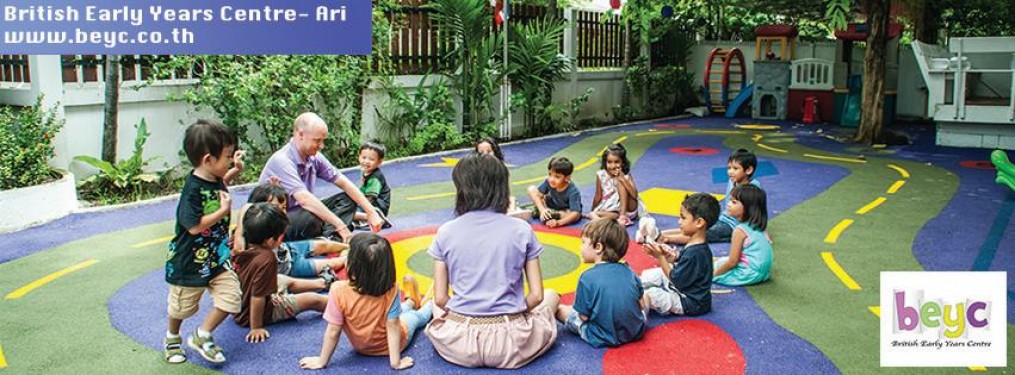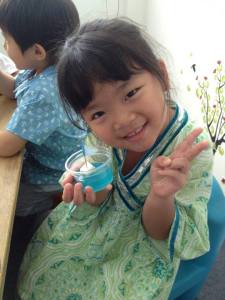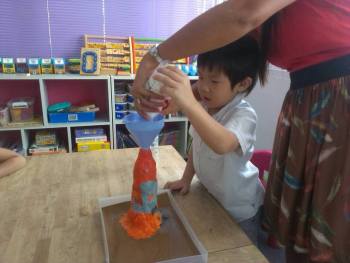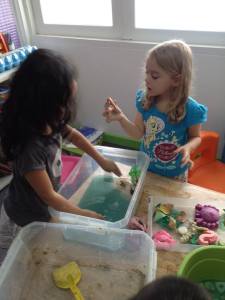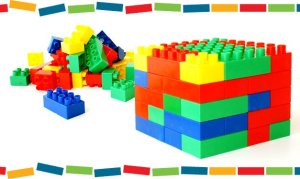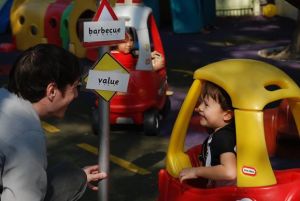children
The development of fine motor skills in young children
What are motor skills?
The development of st rong fine motor skills is essential for young children. Motor skills are a term given to the movements of the body. They fall into two main categories: gross motor skills and fine motor skills. Gross motor skills encompass the development of larger muscle movements, such as the swinging of legs and arms, walking or crawling. Fine motor skills are the small muscle movements requiring the use of fingers and hands (Amundson & Weil, 2001; Case-Smith & Shortridge, 1996). The brains of newborn babies are not yet mature enough to make skilled movements and it is generally the more difficult of the skills to develop due to the specific detail in the movements themselves. Using fine motor skills is impossible without gross motor skills and children need to practice and strengthen them together. The importance of the development of motor skills is not just in the movement of the body either, but as Gallahue (1993) says:
rong fine motor skills is essential for young children. Motor skills are a term given to the movements of the body. They fall into two main categories: gross motor skills and fine motor skills. Gross motor skills encompass the development of larger muscle movements, such as the swinging of legs and arms, walking or crawling. Fine motor skills are the small muscle movements requiring the use of fingers and hands (Amundson & Weil, 2001; Case-Smith & Shortridge, 1996). The brains of newborn babies are not yet mature enough to make skilled movements and it is generally the more difficult of the skills to develop due to the specific detail in the movements themselves. Using fine motor skills is impossible without gross motor skills and children need to practice and strengthen them together. The importance of the development of motor skills is not just in the movement of the body either, but as Gallahue (1993) says:
“Movement is at the very center of young children’s lives. It is an important facet of all aspects of their development, whether in the motor, cognitive, or affective domains of human behavior. To deny children the opportunity to reap the many benefits of regular, vigorous physical activity is to deny them the opportunity to experience the joy of efficient movement, the health effects of movement, and a lifetime as confident, competent movers”. (p. 24)
What if my child has weak fine motor skills?
Development of fine motor skills early gives children a good footing in which to build. According to Gesell and Amatruda (1947) development proceeds in a cephalo–caudal (head to toe) and proximal–distal (moving from the body parts closest to the trunk to those furthest away) pattern. Early development of the shoulders and upper arms allows the children to begin to feed themselves early and helps them to develop pre-writing skills. The development of a strong trunk will also help children to sit properly and maintain good posture (www.fingergym.info/downloads/Finemotordevpp1-4.pdf)
Children with weaker fine motor skills are not just affected by weak movements, but it reciprocates into other aspects of their lives. Children will often become frustrated when they can’t perform simple skills, leading to a refusal to join in with activities.They might get angry or in some cases they make excuses to avoid the task, “I need to go to the toilet”. It can be very sad for young children who may begin to feel separated from their friends.
How can I help strengthen my child’s fine motor skills?
There are many different games you can play and tasks that you can set for your child in order to strengthen their fine motor skills. Starting early is the key to consistent, strong growth and a lot of the activities are good fun too. Imagination Tree offer great ideas. Click here to see their fantastic blog. For younger children and to get a really early start take a look at parents.com.
Benefits of Reading 2- Ideas and Activities
Reading in the womb
It is never too early to begin reading to your child. Even reading whilst the child is in the womb has been proven to have significant benefits to their abilities. The University of Florida found that a Foetus between the 28th and 34th weeks of pregnancy could remember familiar nursery rhymes. These findings suggest that babies are much more susceptible to being influenced by their surroundings before birth than previously thought.
There are many different ways you can stimulate your baby whilst they are in the womb:
- Sharing music and play some classical songs while allowing your child to listen.
- Read simple stories or tell your child what has been happening that day.
- Sing simple songs and nursery rhymes.
- Talk to your child and allow them to hear different familiar voices; siblings; Aunt Kate; Uncle Robert; Dad and Mum.
Reading with babies
According to The American Academy of Pediatrics reading is an essential part of quality development. It stimulates imagination, creativity and improves communication skills. It also introduces children to numbers, letters, colours, shapes and other topics. This is the age when a two way interaction between parent and child can begin to form.
- Children love routine, so making a set time to read with your child is vital. This will set the foundation for your child to enjoy reading right the way through childhood.
- Your child won’t understand everything that you are saying but by reading together and looking at the books, your child will start to recognize every day words.
- Choose brightly coloured books with simple pictures. You don’t want to overload your child with too much information; allow them to use their own creativity. As you read with your child, point to pictures, change the sound of your voice to suit different characters and allow your child time on each page. Interactive books that you can touch and feel are great for children to develop their senses.
- Reciting nursery rhymes and dancing is also a great way to stimulate creativity and imagination. Don’t fall into the trap of just reading them out to your child, rather, be energetic, smile and bring the songs and stories to life. Your child will react to your body language so remember to enjoy this moment yourself.
- Using your child’s toys to make up stories also breeds familiarity and allows the children to continue their creativity when you stop reading.
Reading with young children
Between the ages of 2 and 3 children see a huge development in language and vocabulary skills. In fact according to Barbara Zurer Pearson, author of “Raising a bilingual child”, children are even capable of distinguishing between languages, so the more languages they are surrounded by the better. This is also a great age for sharing reading as children become more responsive. There are many phonics games that you can play at this age and these can be found on our videos page on facebook as well as on our phonics page within the blog. In terms of just reading there are many ways to share:
- Choose books with repetition- Children love knowing what’s coming next and love repeating phrases they are familiar with. It brings them into the story and enables them to join in without being able to read themselves.
- Act out the story with your child- Once you finish reading a story and the child is familiar with it, act it out. You could build a castle out of bed sheets, or houses made of sticks and really get your child living the story.
- Ask children to draw their favourite character from the story- Discuss what clues from the story help describe the character. You could even ask the children to make up a new character for the story.
- Hot seat- Let children read their favourite book and then put them in the hot seat. They can choose their favourtie character before being interviewed on their role in the story. Swap roles and let them ask you as well.
- Make up a story together- With your child verbally make up a story together. You could take this one further and write captions and let your child illustrate; creating your own story book together.
- Make a photo story- Take a trip with your child and take photos together. Allow your child to create sentences about what you are doing in each photo. With more advanced learners you could write a joint diary writing down how you felt at different parts of the day. This also allows the children to empathise with your feelings and perspectives as well.
- Look for books together- One of the most overlooked and important parts of reading, is going to find books together; ones that you can both share.
- Hidden messages- This is a fun way to get your child to enjoy reading. Write them special notes and leave them round the house. Reward them for finding them, “ask Mum for a cookie”.
- Treasure hunts- Children love going on treasure hunts. Dress up as pirates for the day and set up an obstacle course. Take children round the house following clues to find the treasure.
- Role play- Sit and have tea with your child’s dolls, or act out a World Cup final. Find out what your child enjoys and make up a story with them. You can either improvise or make up the story first and then act it out.
- Share the reading load- If your child is beginning to read independently, it can seem daunting to have to read a whole book or even a whole page so break it up. Read one line each and act like you are struggling. Ask for help rather than demand your child reads. Let your child know that even adults struggle at times and it is nothing to be ashamed of.
The most important part of shared reading is to look for the things that your child enjoys the most. Not all of these ideas will work for every child. There are many ways to peak a child’s interest. Try to pick ideas that share the reading experience and you will both be much happier for it.
For more information on the benefits of reading, please take a look at our earlier post The Benefits of Reading With Children
Discovery boxes
One of my fondest memories of being young was my “busy box”. In my busy box were a variety of objects, from recycled egg boxes and felt strips to plastic bottles and cereal boxes. It was my treasure chest of creativity. Anything that could be reused was put into my box by my Mum. It was such a simple thing, but I loved it. I wasn’t the most imaginative child but when I opened my busy box my mind became a factory of ideas. My busy box was always around handy for a rainy day and what was even better was that a close friend had one of his own, so whenever we went to one another’s houses, we would often share pieces of junk. Not only did it fuel my creativity but it helped me develop relationships with friends through play.
Here are some great ideas to help you start your own busy box, courtesy of Imagination Tree…
Family Structure: Its Importance and How to Create It
“Structure offers children a sense of security and control in a world full of uncertainty – and helps create healthy habits that last into adulthood.”
Play is an essential part of growing up, but is it any kind of play? How much should be dictated to them? Guided play at British Early Years Centre is set up in a way that nurtures the children’s curiosity and discovery. Children need to feel in command. Including the children in the making of this structure rather than dictating to them can be the difference between good and bad parenting or teaching.
To read more please take a look here or click on the photo below. A great blog and an interesting article.
Applying play to discipling children
Discipling your child in the correct way is vital. Children need to learn the difference between right and wrong, however this can sometimes be difficult and lead to children being scared to express themselves and challenge authority. It is important to always allow time to explain to your child why you are disappointed with their behaviour and give them a chance to think about the consequences of their actions. A lot of the time children don’t know why they are being punished even though it is obvious to us adults.
Here are some great ideas that encourage discipline through creative play. Not only can your child learn rules but also they can begin to empathise through role play and find the correct ways to channel their frustrations. The activities also give parents a chance to see their children in a different light and may help in finding the route of bad behaviour.
http://truparenting.net/5-specific-examples-apply-play-discipline/
Just how important is Early Years Education? The answer- more than we know
“90% of the brain develops between the ages of zero to five, yet we spend 90% of our dollars on kids above the age of five,” says Timothy Knowles of the University of Chicago. That is now changing.
The importance of Early Education is becoming more and more apparent. This article in the Economist (here) discusses the issue with statistics. It compares education systems from different countries and begins to look at the future of how we approach the Early Years.
“O” for orange- water play activity
For younger children it is not only important to help them to grasp a concept of phonics and maths but also to encourage them to explore themselves and the world around them. Here is a great idea involving manipulative water based play. It is a holistic learning activity; great fun for any young child. Click here for more details.

The importance of a healthy Early Years education
We all know that it is important to lead a healthy life and to teach our children the right choices, but how important is it that the children’s school looks after their needs? This scientific research explains that it is vital. Read more here…
5 Things Teachers Wish Parents Knew: Your Children Can Do More Than You Think
“This week, I’m turning the tables and giving some space to the “teacher” half of the “Parent-Teacher Conference.” When I ask teachers, “What one thing would you want your students’ parents to know?” the same five points come up over and over again.”
There are so many wonderful things that your children are capable of. It is not a matter of pushing them to achieve their potential, but rather a matter of giving them the inspiration and curiosity to push themselves. Read here to find out more.
